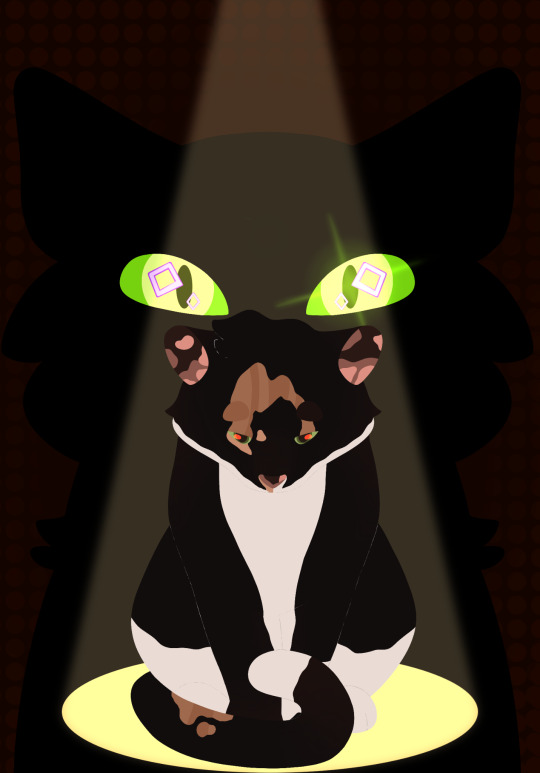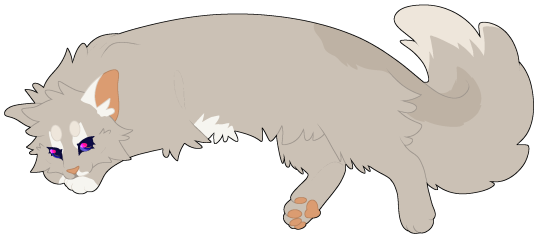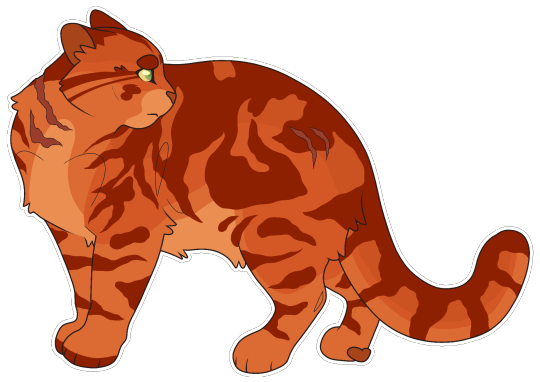#ravenbite
Explore tagged Tumblr posts
Text






some @solsticewcrp made over the last months!
Ravenbite, Nymphwish, Milkroot, Foxthorn and Flyhiss belong to me
Wanewhisper belongs to @laneelliot12 !
#warrior cats#my art#warrior cats oc#warrior cats rp#warriors#solsticerp#ravenbite#nymphwish#wanewhisper#milkroot#foxthorn#flyhiss
12 notes
·
View notes
Photo

gift for Kyldrun and ravenbite on dA
136 notes
·
View notes
Text
reborn warrior episode 1

sliverbreeze was a fresh warrior of riverclan before she died
her parents are frozenpool(tom) and graytail(she-cat)
Her grandparents(frozenpool parents) are cloverwatcher(enby) and lightshade(she-cat)
Her other grandparents(graytail parents) are beartuft(she-cat) and stonestride(trans she-cat)
Her uncles are snowpaw(died as a appreciate) and shellstep (frozenpool brothers)
Her aunt(shellstep mate) is elkheart(become deputy after sliverbreeze died)
Her great-grandparents (frozenpool grandparents) are winterscar(tom) and webbreeze(trans tom)
Her other great grandparents (graytail parents) are rockystar (tom,leader before brownstar and softstar(sliverbreeze leader) and duskstorm (she-cat)
Now her personality:a cheerful cat who's ready to learn anything
history:sliverbreeze is born as sliverkit to frozenpool and graytail
she love her parents but her favorite cat has be her uncle shellstep
shellstep told sliverkit stories of cats such as her uncle snowpaw,former riverclan leader brownstar,and shellstep mentor ravenbite
sliverkit love hearing the stories especially with her best friend blizzardkit(she-cat)
Blizzardkit didn't have littermates just like sliverkit so they played with eachother and become best of friends
sliverkit and blizzardkit become appreciates at 6 moons,they are both renamed sliverpaw and blizzardpaw
Sliverpaw mentor is black-furred cat with Amber eyes named nightberry while blizzard paw mentor is sliverpaw's aunt elkheart
nightberry is good mentor to sliverpaw and sliverpaw admire nightberry cleverness
Sliverpaw still hang out with blizzardpaw when she's not training
unfortunately her grandparent cloverwatcher passed away and everyone morn them(lightshade,beartuft,and stonestride passed away before sliverpaw was born)
Sliverpaw was rightfully sad but eventually got over it
sliverpaw and blizzardpaw became warriors and are renamed sliverbreeze and blizzardmoon
unfortunately after a moon,sliverbreeze got sick and everyone is worried including blizzardmoon
rosebud and lilacpetal(medicine cats) try their best to cure sliverbreeze sickness
but with even their effort,sliverbreeze passed away from sickness
sliverbreeze family and friends attended sliverbreeze funeral and remember how cheerful sliverbreeze is
Little do they know that sliverbreeze will come back but as someone else
fun facts:sliverbreeze is a lesbian and have a crush on blizzardmoon but never realize her true feelings until after her death
2 notes
·
View notes
Photo

Ravenbit Logo Design \\\ Follow 👉 [@logo.rax] 👈 for more... Looking For A Logo? Just Send a Direct Message 💬 . #logo #designer #logodesigner #graphic #design #graphicdesigner #branding #nerd #technicians #photooftheday #techo #technic #technik #dj #technics #technews #electronic #music #gadget #techouse #gadgets #electronics #instatech #geek #techy #techie #techno #tech #technology . #raxart . Effort honedon.co (at London, United Kingdom) https://www.instagram.com/p/BsbI6Q_h4Rw/?utm_source=ig_tumblr_share&igshid=kpw6dswmfkxh
#logo#designer#logodesigner#graphic#design#graphicdesigner#branding#nerd#technicians#photooftheday#techo#technic#technik#dj#technics#technews#electronic#music#gadget#techouse#gadgets#electronics#instatech#geek#techy#techie#techno#tech#technology#raxart
2 notes
·
View notes
Photo

"Logo Inspiration" Follow us 👉 @TwineLogos 👌 . ravenbit by @honedon.co . 🛑 WANT MORE DESIGN INSPIRATION? 🛑 . Follow us at @TwineUIDesign and @JoinTwine . 🌎 Go to www.twine.fm 👍 "Empowering Creatives" on Instagram: http://ift.tt/2fTquSq http://ift.tt/2hzMhlW http://ift.tt/2fTquSq http://ift.tt/2fTed0q
9 notes
·
View notes
Photo

👈 ravenbit by @honedon.co - ➡️ logocore.com/learnlogodesign ➡️ www.logoinspirations.co/
1 note
·
View note
Text
Регулирование уничтожило индустрию физических биткоинов

В то время как поклонни��и биткоинов празднуют десятилетнюю годовщину изобретения Сатоши, ветераны отмечают, что многое изменилось с первых дней. Одним из популярных бизнесов на заре криптовалют было производство физических «загруженных» биткоинов. Однако со временем правительственные запреты практически искоренили этот сектор. Вскоре после запуска биткоина люди начали создавать бумажные кошельки, а затем родилась концепция физических биткоинов. Позже концепт перешёл на более высокий уровень – люди стали «чеканить» физические биткоины. Физические биткоины от Casascius быстро обратили на себя внимание коллекционеров. Однако, когда Майк Колдуэлл, создатель Casascius, начал продавать физические биткоины, на которые были загружены целые биткоины или их доли, им заинтересовалась Сеть по борьбе с финансовыми преступлениями США, которая заставила его закрыть проект. Американский регулятор посчитал выпуск монет Casascius «незаконной трансмиссией денег», и Колдуэлл был вынужден прекратить чеканку. С тех пор несколько других предпринимателей пытались наладить аналогичное производство, продавая инвесторам физические монеты с загруженными на них биткоинами. Эти деньги находили спрос даже у нумизматов, равнодушных к биткоину, как таковому.

Эта монета Casascius, содержащая один биткоин, была продана на Ebay 13 января 2018 года за $28 700, когда биткоин стоил $14 300. В период между 2013 и 2016 годами физические биткоины пользовались немалой популярностью, и в среде коллекционеров на них сохранялся устойчивый спрос. Отдельные монеты Casascius продавались по цене, превосходившей загруженную в них стоимость, в 4-10 раз. В те дни физических биткоинов в обращении было так много, что Элиас Ахонен даже опубликовал целую энциклопед��ю физических биткоинов. Однако в последние годы этот тренд сошёл на нет. Компании Ravenbit, Alitin Mint, Cryptmint и Titan Bitcoin ушли из этого бизнеса. В апреле прошлого года японская компания Satori Coin сообщила клиентам, что вынуждена прекратить производство физических биткоинов, уступая давлению Агентства по финансовым услугам. Аналогичным образом, криптовалютная компания BTCC прекратила выпуск физических биткоинов в октябре 2018 года.

Монеты Titan с загруженными на них биткоинами. Компания Titan ушла из бизнеса. Сооснователь компании Бобби Ли рассказал в Twitter о том, как в Китае продажи физических биткоинов BTCC Mint достигли рекордных высот, до того, как прекратились. Компания успела выпустить последнюю серию монет в 2018 году, и они по-прежнему доступны покупателям из США через фирму Rogue Bitcoin. В целом, на вторичных рынках в продаже по-прежнему много физических биткоинов, поскольку их в своё время купили третьи стороны, и теперь торгуют ими с немалой для себя выгодой. Монеты Casascius, Satori, Titan и BTCC можно купить на Ebay и многих других аукционах и сайтах сетевой торговли, однако цены завышены в разы в сравнении с первоначальными, и превосходят стоимость, заложенную в монеты в цифровом виде.

Монеты Satori с загруженными на них биткоинами. В апреле прошлого года этот японский производитель объявил, что вынужден прекратить работу, уступая давлению местного регулятора. Главная причина, по которой все эти компании вышли из игры, – гонения со стороны регуляторов. Например, власти США готовы терпеть людей, которые обмениваются криптовалютами в цифровом виде, в соответствии с правилами. Но для них неприемлема идея физических монет с загруженными биткоинами или любого другого аналогичного инструмента, наподобие бонда, который способен конкурировать с американским долларом.

Liberty Dollars, созданные Бернардом фон Нотхаусом. Американским правоохранительным органам не понравилось то, что монеты Liberty Dollar несут на себе знак доллара ($), а также слова «доллар», «США», «Свобода», «Вера в Бога» (вместо «В Бога мы веруем»), и имеют другие отличительные черты законной американской фиатной валюты. 18 марта 2011 года власти США обвинили шестидесятилетнего Нотхауса в создании этой монеты. Прокурор Анне Томпкинс сурово заявила: «Попытки принизить достоинство легитимной валюты этой страны (США) – просто неслыханная форма терроризма». Сейчас многие компании по-прежнему продают металлические «биткоины», не содержащие цифровые активы, но есть исключение – компания Denarium торгует физическими монетами (из бронзы, серебра и даже золота) с загруженной ценностью:

Сами монеты производит финская компания Prasos. Приватные ключи покрыты устойчивой к взлому голограммой. Одни монеты от Denarium содержат по одному биткоину каждая, монеты другого типа позволяют клиенту самому загрузить энную сумму. На монету серии Denarium Custom Gold Plated 2018 можно загрузить максимум два биткоина. Помимо Denarium и вторичных рынков, с их завышенными ценами, физических биткоинов уже не осталось. Read the full article
0 notes
Link
Economy & Regulation
As bitcoiners celebrate the 10th anniversary of Satoshi’s invention, veteran enthusiasts will be aware that a lot has changed since the early days. One business that was once incredibly popular is the art of manufacturing loaded physical bitcoins. Government regulations have forced operations to cease, causing the physical bitcoin minting business to virtually grind to a halt.
Also read: 8 Crypto Debit Cards You Can Use Around the World Right Now
Manufacturing Loaded Physical Bitcoins Is a Lost Art
Not long after Bitcoin was launched, people managed to create paper wallets and soon the concept of physical bitcoins was born. After that, individuals took the idea to another level and minted metal bitcoins were created. Casascius coins quickly became a collector’s item with these shiny keepsakes loaded with digital currency. However, after Mike Caldwell, the creator of Casascius coins, started selling his physical bitcoins loaded with whole units or fractions of BTC, he was shut down by the U.S. Financial Crimes Enforcement Network (FinCEN). The U.S. regulator considered minting Casascius coins illegal money transmission and Caldwell had to stop selling loaded coins. Since then a number of other manufacturers have attempted to sell loaded bitcoins to investors who may find numismatic value in these physical collections.
This Casascius coin funded with 1BTC sold for $28,700 on Ebay a year ago on Jan. 13, 2018. At the time of sale, 1BTC was worth $14,300.
From 2013-2016, physical bitcoins were extremely popular and demand for these coins has remained robust among collectors. Some rare Casascius coins have sold for more than 4-10X their loaded value. In the early days there were so many physical bitcoins that cryptocurrency proponent Elias Ahonen managed to author an entire encyclopedia of physical bitcoins. In recent years, however, the art of molding loaded physical bitcoins is all but lost. Companies like Ravenbit, Alitin Mint, Cryptmint and Titan Bitcoin have all gone out of business. Last April the Japanese manufacturer Satori Coin told customers it was forced to close operations due to the Financial Services Agency’s AML/KYC standards introduced in 2018. Similarly, the cryptocurrency firm BTCC launched its own physical bitcoin forge and ended its operations in October 2018.
Loaded Titan Bitcoins. The physical bitcoin manufacturer Titan is no longer in business.
Bobby Lee, the co-founder of the company, explained to his Twitter followers how BTCC Mint’s physical bitcoin sales in China touched record highs before it closed operations. The mint did manage to produce a 2018 series, which is still available to U.S. customers through a company called Rogue Bitcoin. In fact, there are plenty of physical bitcoins for sale on secondary markets as third parties have managed to hoard these coins and sell them for a profit. On Ebay, and many other auction and e-commerce websites, there are plenty of Casascius, Satori, Titan, and BTCC loaded coins. However, collectors will find that prices are way higher than what the coin was sold for originally and well above what it holds digitally.
Loaded Satori coins. The Japanese manufacturer announced this past April it had to close up shop due to the FSA’s strict regulations.
Governments Don’t Like Competing Bearer Bond Instruments
The biggest reason for most of these firms going out of business is predominately overreaching regulation. The U.S. government, for instance, may be okay with people exchanging cryptocurrency in a regulated manner digitally. However, issuing physical bitcoins that are loaded or any other type of manufactured bearer bond instrument that competes with the U.S. dollar is not a good idea and you could wind up in prison.
Liberty Dollars created by Bernard von Nothaus. U.S. law enforcement said the Liberty Dollar coins were marked with the dollar sign ($); the words dollar, USA, Liberty, Trust in God (instead of “In God We Trust”); and other features associated with legal US coinage.
This can also happen to coin creators even if the products are minted without digitally loaded value inside them. On March 18, 2011, the U.S. government convicted 67-year old Bernard von Nothaus for being the monetary architect of a currency. Essentially von Nothaus’s “Liberty Dollar” operations ended immediately and U.S. Attorney Anne Tompkins did not take kindly to the creation. “Attempts to undermine the legitimate currency of this country are simply a unique form of domestic terrorism,” Tompkins explained at the time.
Denarium products can still be purchased from the Finland-based dealer with up to 2BTC loaded on certain coins.
There are plenty of coin makers that sell metal ‘bitcoins’ with no digital funds, but there is one company that still issues physical bitcoins that are loaded. Denarium sells a variety of pre-funded physical coins in bronze, silver, and even .999 gold. The pieces are made by a Finnish company called Prasos and private keys are covered by a tamper-resistant hologram. Some of Denarium’s products have units like 1 BTC tied to them, while with other types of coins, the customer can add a custom sum. The Denarium Custom Gold Plated 2018 piece can be loaded with fractions of BTC and up to a maximum of 2 BTC per coin. Besides Denarium and overpriced secondary markets, finding physical cryptocurrency manufacturers who are willing to sell coins loaded, unfortunately, is now all but impossible.
What do you think about the lack of physical bitcoin manufacturers in 2019? Let us know what you think about this subject in the comments section below.
Images via Denarium, Satori coins, Titan Bitcoins, BTCC Mint, Casascius, and Pixabay.
Have you seen our widget service? It allows anyone to embed informative Bitcoin.com widgets on their website. They’re pretty cool, and you can customize by size and color. The widgets include price-only, price and graph, price and news, and forum threads. There’s also a widget dedicated to our mining pool, displaying our hash power.
(function(d, s, id) { var js, fjs = d.getElementsByTagName(s)[0]; if (d.getElementById(id)) return; js = d.createElement(s); js.id = id; js.src = 'https://connect.facebook.net/en_US/sdk.js#xfbml=1&version=v3.2'; fjs.parentNode.insertBefore(js, fjs); }(document, 'script', 'facebook-jssdk'));
0 notes
Text
Is Online Collecting Next?
Coin collectors are used to being able to see, touch, and examine their coins. They can share their coins with others. They can belong to clubs. They can visit coin shows. They can bid at auctions. The stuff is physical.
Coin collecting remains popular worldwide, even though there are indications the number of active collectors in the United States has been on the decline for some time.
When I say coin collecting has remained popular worldwide, I mean physical coin collecting. What about collecting coins online? You own the coin, but the coin isn’t a physical entity. It only exists in cyberspace. It is real. You paid real money to purchase it. It can be spent—online. It can be viewed—online. People invest in cybermoney just as they do in bullion price impacted coins such as the Silver American Eagle, Austrian gold Philharmonic and many other physical coins. Cybermoney needs to be protected, but you don’t need a safe or to pay a fee to have someone else to store it for you.
There aren’t any coin dealers selling online coins, or are there? They may belong to national or regional coin collecting organizations if they sell physical coins as well, they certainly don’t belong if their only product is something from cyberspace.
The question coin collectors, as well as governments and financial institutions, debate regards if cryptocurrencies are real money? What makes these nebulous things have value is they are decentralized? The individual has more control and security over his digital money. Furthermore, the individual doesn’t have to deal with third party middlemen when buying, selling, or transacting with these forms of currency. A government can’t draw a line around where these forms of money can be used or must be exchanged for another currency.
Wait a minute. Doesn’t this appear as if you are using bullion valued coins, but you don’t have to worry about using a bank, broker, or other middleman? Doesn’t this sound eerily similar to the bullion 0.999 fine silver Liberty dollar issues produced by Bernard von NotHaus? Von NotHaus was convicted of counterfeiting for that reason in 2011, allegedly for the purpose of domestic terrorism. Von NotHaus and others have issued physical barter that has been nixed by a government. Governments have a monopoly on issuing coins and bank notes—legally.
And, what about physical cybermoney? Not all cybermoney is ‘lost in space.’ According to a March 21 NewsBitCoin.com online article, “Government regulations have forced operations to cease, causing the physical bitcoin minting business to virtually grind to a halt. Not long after Bitcoin was launched, people managed to create paper wallets and soon the concept of physical bitcoins was born. After that, individuals took the idea to another level and minted metal bitcoins were created. Casascius coins quickly became a collector’s item with these shiny keepsakes loaded with digital currency.”
The article continues, “Mike Caldwell, the creator of Casascius coins, started selling his physical bitcoins loaded with whole units or fractions of BTC [when] he was shut down by the US Financial Crimes Enforcement Network (FinCEN). The US regulator considered minting Casascius coins illegal money transmission and Caldwell had to stop selling loaded coins. Since then a number of other manufacturers have attempted to sell loaded bitcoins to investors who may find numismatic value in these physical collections.”
“Companies like Ravenbit, Alitin Mint, Cryptmint and Titan Bitcoin have all gone out of business,” according to the NewsBitCoin.com article. “The [BTCC] mint did manage to produce a 2018 series, which is still available to US customers through a company called Rogue Bitcoin. In fact, there are plenty of physical bitcoins for sale on secondary markets as third parties have managed to hoard these coins and sell them for a profit.”
Prasos is a privately owned mint in Finland that strikes physical bronze, silver, and gold composition cybercoins for a company called Denarium. These cybercoins are protected with tamper-resistant holograms. Doesn’t this sound awfully similar to the security devices now being introduced on some government-issued coins? It begs the question: what is the difference between physical cybermoney and tokens?
A 2018 Quora.com article asks if mining cryptcurrency can be a fun hobby? Perhaps both physically and in cyberspace we are looking at an extension of numismatics we have yet to recognize as such?
This article was originally printed in World Coin News. >> Subscribe today.
The post Is Online Collecting Next? appeared first on Numismatic News.
0 notes
Text
Regulations Have Ruined the Physical Bitcoin Industry
As bitcoiners celebrate the 10th anniversary of Satoshi’s invention, veteran enthusiasts will be aware that a lot has changed since the early days. One business that was once incredibly popular is the art of manufacturing loaded physical bitcoins. Government regulations have forced operations to cease, causing the physical bitcoin minting business to virtually grind to a halt.
Also read: 8 Crypto Debit Cards You Can Use Around the World Right Now
Manufacturing Loaded Physical Bitcoins Is a Lost Art
Not long after Bitcoin was launched, people managed to create paper wallets and soon the concept of physical bitcoins was born. After that, individuals took the idea to another level and minted metal bitcoins were created. Casascius coins quickly became a collector’s item with these shiny keepsakes loaded with digital currency. However, after Mike Caldwell, the creator of Casascius coins, started selling his physical bitcoins loaded with whole units or fractions of BTC, he was shut down by the U.S. Financial Crimes Enforcement Network (FinCEN). The U.S. regulator considered minting Casascius coins illegal money transmission and Caldwell had to stop selling loaded coins. Since then a number of other manufacturers have attempted to sell loaded bitcoins to investors who may find numismatic value in these physical collections.
This Casascius coin funded with 1BTC sold for $28,700 on Ebay a year ago on Jan. 13, 2018. At the time of sale, 1BTC was worth $14,300.
From 2013-2016, physical bitcoins were extremely popular and demand for these coins has remained robust among collectors. Some rare Casascius coins have sold for more than 4-10X their loaded value. In the early days there were so many physical bitcoins that cryptocurrency proponent Elias Ahonen managed to author an entire encyclopedia of physical bitcoins. In recent years, however, the art of molding loaded physical bitcoins is all but lost. Companies like Ravenbit, Alitin Mint, Cryptmint and Titan Bitcoin have all gone out of business. Last April the Japanese manufacturer Satori Coin told customers it was forced to close operations due to the Financial Services Agency’s AML/KYC standards introduced in 2018. Similarly, the cryptocurrency firm BTCC launched its own physical bitcoin forge and ended its operations in October 2018.
Loaded Titan Bitcoins. The physical bitcoin manufacturer Titan is no longer in business.
Bobby Lee, the co-founder of the company, explained to his Twitter followers how BTCC Mint’s physical bitcoin sales in China touched record highs before it closed operations. The mint did manage to produce a 2018 series, which is still available to U.S. customers through a company called Rogue Bitcoin. In fact, there are plenty of physical bitcoins for sale on secondary markets as third parties have managed to hoard these coins and sell them for a profit. On Ebay, and many other auction and e-commerce websites, there are plenty of Casascius, Satori, Titan, and BTCC loaded coins. However, collectors will find that prices are way higher than what the coin was sold for originally and well above what it holds digitally.
Loaded Satori coins. The Japanese manufacturer announced this past April it had to close up shop due to the FSA’s strict regulations.
Governments Don’t Like Competing Bearer Bond Instruments
The biggest reason for most of these firms going out of business is predominately overreaching regulation. The U.S. government, for instance, may be okay with people exchanging cryptocurrency in a regulated manner digitally. However, issuing physical bitcoins that are loaded or any other type of manufactured bearer bond instrument that competes with the U.S. dollar is not a good idea and you could wind up in prison.
Liberty Dollars created by Bernard von Nothaus. U.S. law enforcement said the Liberty Dollar coins were marked with the dollar sign ($); the words dollar, USA, Liberty, Trust in God (instead of “In God We Trust”); and other features associated with legal US coinage.
This can also happen to coin creators even if the products are minted without digitally loaded value inside them. On March 18, 2011, the U.S. government convicted 67-year old Bernard von Nothaus for being the monetary architect of a currency. Essentially von Nothaus’s “Liberty Dollar” operations ended immediately and U.S. Attorney Anne Tompkins did not take kindly to the creation. “Attempts to undermine the legitimate currency of this country are simply a unique form of domestic terrorism,” Tompkins explained at the time.
Denarium products can still be purchased from the Finland-based dealer with up to 2BTC loaded on certain coins.
There are plenty of coin makers that sell metal ‘bitcoins’ with no digital funds, but there is one company that still issues physical bitcoins that are loaded. Denarium sells a variety of pre-funded physical coins in bronze, silver, and even .999 gold. The pieces are made by a Finnish company called Prasos and private keys are covered by a tamper-resistant hologram. Some of Denarium’s products have units like 1 BTC tied to them, while with other types of coins, the customer can add a custom sum. The Denarium Custom Gold Plated 2018 piece can be loaded with fractions of BTC and up to a maximum of 2 BTC per coin. Besides Denarium and overpriced secondary markets, finding physical cryptocurrency manufacturers who are willing to sell coins loaded, unfortunately, is now all but impossible.
What do you think about the lack of physical bitcoin manufacturers in 2019? Let us know what you think about this subject in the comments section below.
Images via Denarium, Satori coins, Titan Bitcoins, BTCC Mint, Casascius, and Pixabay.
Have you seen our widget service? It allows anyone to embed informative Bitcoin.com widgets on their website. They’re pretty cool, and you can customize by size and color. The widgets include price-only, price and graph, price and news, and forum threads. There’s also a widget dedicated to our mining pool, displaying our hash power.
The post Regulations Have Ruined the Physical Bitcoin Industry appeared first on Bitcoin News.
[Telegram Channel | Original Article ]
0 notes
Photo

#Cryptocurrency RAVENBIT BITCOIN SERIES 2.1 NODE COPPER LIMITED EDITION OF 250 LEALANA CASASCIUS http://dlvr.it/Q4vNMf /**Brought To You By- http://dld.bz/fHqq6
0 notes
Text
Is Online Collecting Next?
Coin collectors are used to being able to see, touch, and examine their coins. They can share their coins with others. They can belong to clubs. They can visit coin shows. They can bid at auctions. The stuff is physical.
Coin collecting remains popular worldwide, even though there are indications the number of active collectors in the United States has been on the decline for some time.
When I say coin collecting has remained popular worldwide, I mean physical coin collecting. What about collecting coins online? You own the coin, but the coin isn’t a physical entity. It only exists in cyberspace. It is real. You paid real money to purchase it. It can be spent—online. It can be viewed—online. People invest in cybermoney just as they do in bullion price impacted coins such as the Silver American Eagle, Austrian gold Philharmonic and many other physical coins. Cybermoney needs to be protected, but you don’t need a safe or to pay a fee to have someone else to store it for you.
There aren’t any coin dealers selling online coins, or are there? They may belong to national or regional coin collecting organizations if they sell physical coins as well, they certainly don’t belong if their only product is something from cyberspace.
The question coin collectors, as well as governments and financial institutions, debate regards if cryptocurrencies are real money? What makes these nebulous things have value is they are decentralized? The individual has more control and security over his digital money. Furthermore, the individual doesn’t have to deal with third party middlemen when buying, selling, or transacting with these forms of currency. A government can’t draw a line around where these forms of money can be used or must be exchanged for another currency.
Wait a minute. Doesn’t this appear as if you are using bullion valued coins, but you don’t have to worry about using a bank, broker, or other middleman? Doesn’t this sound eerily similar to the bullion 0.999 fine silver Liberty dollar issues produced by Bernard von NotHaus? Von NotHaus was convicted of counterfeiting for that reason in 2011, allegedly for the purpose of domestic terrorism. Von NotHaus and others have issued physical barter that has been nixed by a government. Governments have a monopoly on issuing coins and bank notes—legally.
And, what about physical cybermoney? Not all cybermoney is ‘lost in space.’ According to a March 21 NewsBitCoin.com online article, “Government regulations have forced operations to cease, causing the physical bitcoin minting business to virtually grind to a halt. Not long after Bitcoin was launched, people managed to create paper wallets and soon the concept of physical bitcoins was born. After that, individuals took the idea to another level and minted metal bitcoins were created. Casascius coins quickly became a collector’s item with these shiny keepsakes loaded with digital currency.”
The article continues, “Mike Caldwell, the creator of Casascius coins, started selling his physical bitcoins loaded with whole units or fractions of BTC [when] he was shut down by the US Financial Crimes Enforcement Network (FinCEN). The US regulator considered minting Casascius coins illegal money transmission and Caldwell had to stop selling loaded coins. Since then a number of other manufacturers have attempted to sell loaded bitcoins to investors who may find numismatic value in these physical collections.”
“Companies like Ravenbit, Alitin Mint, Cryptmint and Titan Bitcoin have all gone out of business,” according to the NewsBitCoin.com article. “The [BTCC] mint did manage to produce a 2018 series, which is still available to US customers through a company called Rogue Bitcoin. In fact, there are plenty of physical bitcoins for sale on secondary markets as third parties have managed to hoard these coins and sell them for a profit.”
Prasos is a privately owned mint in Finland that strikes physical bronze, silver, and gold composition cybercoins for a company called Denarium. These cybercoins are protected with tamper-resistant holograms. Doesn’t this sound awfully similar to the security devices now being introduced on some government-issued coins? It begs the question: what is the difference between physical cybermoney and tokens?
A 2018 Quora.com article asks if mining cryptcurrency can be a fun hobby? Perhaps both physically and in cyberspace we are looking at an extension of numismatics we have yet to recognize as such?
This article was originally printed in World Coin News. >> Subscribe today.
The post Is Online Collecting Next? appeared first on Numismatic News.
0 notes
Photo

#Cryptocurrency RAVENBIT BITCOIN SERIES 2.1 NODE COPPER LIMITED EDITION OF 250 LEALANA CASASCIUS http://dlvr.it/Q0zczF /**Brought To You By- http://dld.bz/fHqq6
0 notes
Photo

RAVENBIT BITCOIN FIRST EVER SERIES 272 MINTED 2014 LEALANA CASASCIUS SUPER RARE http://dlvr.it/Pz740V /**Brought To You By- http://dld.bz/fHqq6
0 notes